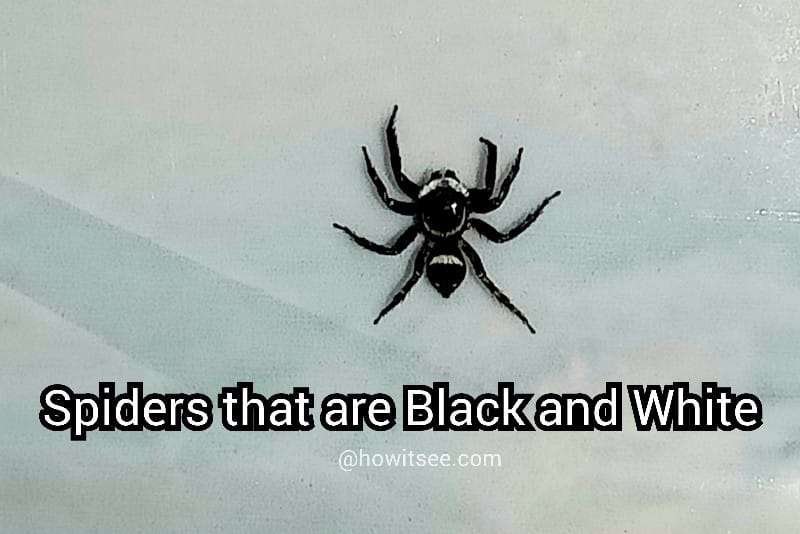Now, we are back with another list of spiders. But this time, it will be a bit different. It’s not about the largest, most venomous or smallest spiders. Here, we have listed spiders that are black and white.
Most of the time, you witness black spiders with white spots and wonder about their species. So, it’s time to answer your curiosity by providing a list of spiders that are black and white. So, from Zebra spiders to Silver Orb Weaving Spiders, let’s begin our article.
28 Black and White Spiders
1) Pantropical Jumper
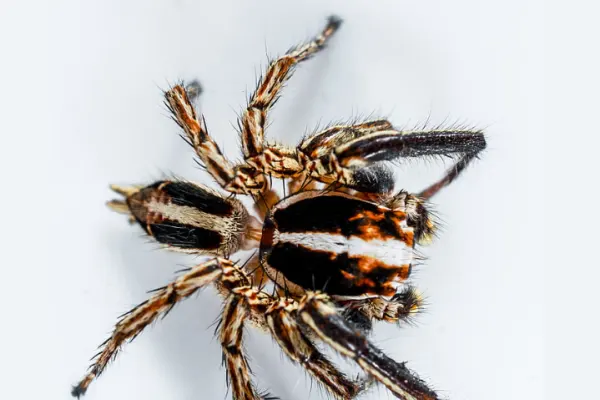
| Scientific name | Plexippus paykulli |
| Size | 9 to 12mm |
| Diet | insects like fruit flies or small crickets |
| Geographical location | tropical regions of Africa and Asia, the southern United States to Paraguay |
Pantropical Jumper is one of the most popular spiders that are black and white. Particularly in the US, these spiders are called Pantropical jumping spiders. In terms of size, there is not much difference between males and females. But the primary distinction is in the color of the carapace.
Males are black in color with white stripes. However, females have brown carapaces with white stripes on the abdomen. Like most jumping spiders, they do not spin webs and rely on their great eyesight and stealth to catch their prey.
Pantropical Jumping spiders feed on Diptera, Hemiptera, Hymenoptera, Lepidoptera, Odonata, Orthoptera and Aranea.
2) Zebra Spider
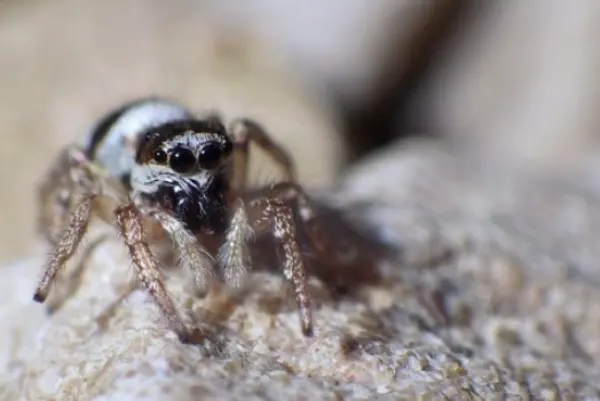
| Scientific name | Salticus scenicus |
| Size | 5 to 7 mm |
| Diet | primarily on insects, including mosquitos and flies |
| Geographical location | widespread across Europe, North America, and North Asia |
When it comes to spiders with black and white color, most people think of Zebra Spiders because they can be easily found across the Northern Hemisphere and have very beautiful black and white, zebra-like coloration on the entire body.
Males are generally smaller than females and have great eyesight. These spiders are also known to see many colors and mainly feed on smaller spiders and other arthropods.
3) Peppered Jumping Spider
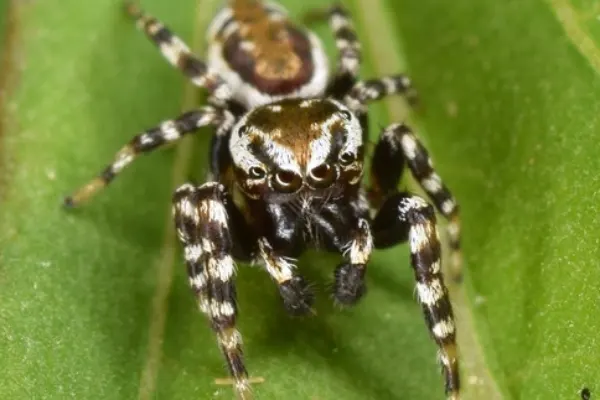
| Scientific name | Pelegrina galathea |
| Size | 3 to 6mm |
| Diet | Flies, mealworms, moths, and other small defenseless prey |
| Geographical location | North America from Canada to Costa Rica |
Peppered Jumping Spiders, also known as Peppered Jumper, is a species of jumping spiders native to North America. Females are generally larger than males and have brown and black colored body with white patterns.
These spiders are diurnal and eat small insects. Peppered Jumping Spiders can be found in sunlit-grassy areas. The normal size of Peppered Jumping Spiders is somewhere between 3 to 6mm, and they feed flies, wasps, grasshoppers, and other small insects.
4) Bold Jumper (Phidippus audax)
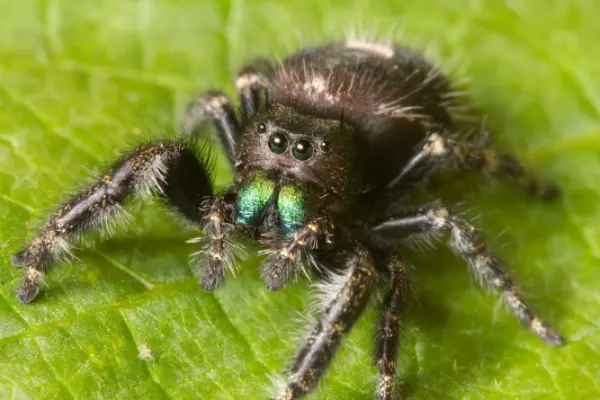
| Scientific name | Phidippus audax |
| Size | 4 to 18mm |
| Diet | a wide variety of insects and other spiders |
| Geographical location | southern Canada, the United States and parts of northern Mexico, Cuba, and Puerto Rico |
Bold Jumper, also known as Bold Jumping Spider, is commonly found in North America. The average length of a male Bold Jumper is around 8mm, whereas females can range from 4 to 18mm.
These spiders can be found in various colors. When bold Jumper turns into mature, their abdomen turns white from various colors. Bold Jumping spiders vary widely in many colors, from yellow, orange, and red to white. They feed on various small insects.
5) Adanson’s House Jumper
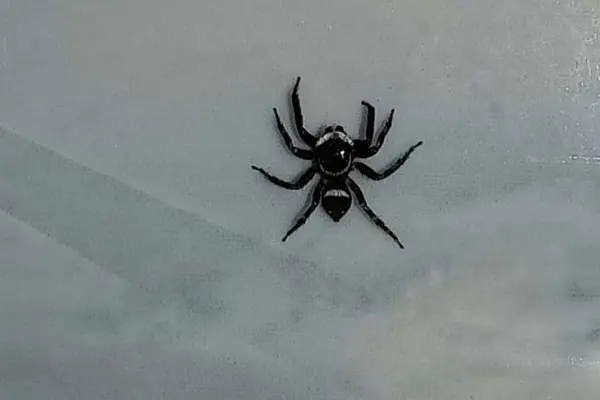
| Scientific name | Hasarius adansoni |
| Size | 6-8mm |
| Diet | other arthropods |
| Geographical location | Malta, India, Japan, Brazil, Taiwan, and Australia |
Adanson’s House Jumper is commonly seen in warmer climatic conditions. The male spiders are completely black in color with white stripes over the body, while the females are dark brown.
Adanson’s House Jumper can grow up to 8mm. These spiders are normally found in our houses and are non-venomous. They eat flies and other small insects.
6) Silver Orb Weaving Spiders
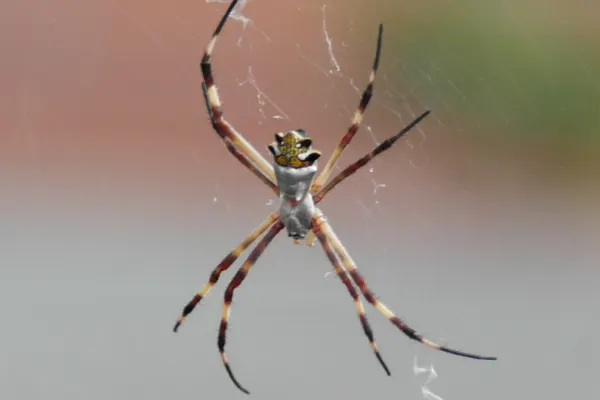
| Scientific name | Argiope argentata |
| Size | 6-15mm |
| Diet | flies and other small insects |
| Geographical location | throughout Australia |
The next Araneoidea in the list of spiders that are black and white is Silver Orb Weaving Spider. These spiders have long silver legs and abdomen comprised of black and white colored patterns. They are also known as Humped Orb Weaving Spiders.
Silver Orb Weaving Spiders have a very long bodies and can grow up to 1cm. They are often found amongst understorey vegetation consisting of grass, water, and shrubs. They make their web and wait for their prey.
Silver Orb Weaving Spiders predominantly feed on flies and other small insects. The main predators of Silver Orb Weaving Spiders are birds and other big insects.
7) Brazilian Black and White Tarantula
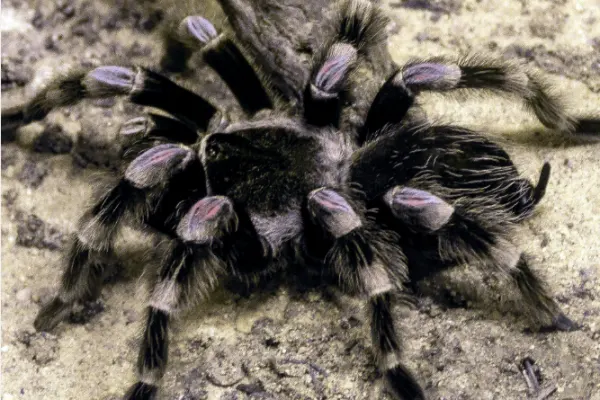
| Scientific name | Nhandu coloratovillosus |
| Size | around 16cm |
| Diet | small mealworms, pinhead crickets, and fruit flies |
| Geographical location | grasslands of Brazil and Paraguay |
The largest spider on the list is Brazilian Black and White Tarantula. These tarantulas can grow up to 16cm, and their growth rate is very fast.
Their body comprises three main colors black, white, and brown. The carapace is primarily black with white stripes and covered in long brownish-orange hairs.
The average lifespan of Brazilian Black and White Tarantula is 13 years for females and four years for males. They are also known as bombardier tarantulas.
Brazilian Tarantulas are found in grasslands where temperatures can reach 35 degrees Celsius. They feed on large insects like crickets, grasshoppers, and small rodents.
8) White Micrathena
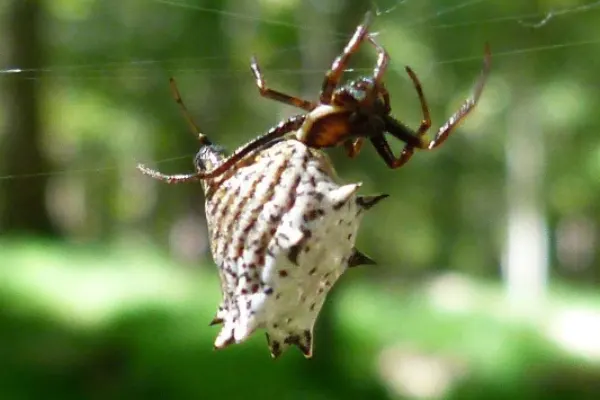
| Scientific name | Micrathena mitrata |
| Size | 3mm to 11mm |
| Diet | flying insects, such as flies, mosquitoes, and moths |
| Geographical location | The United States to Brazil |
White Micrathena is a very small spider and species of orb weaver. They spin tightly coiled webs to capture their prey and feed on them.
White Micrathenaare venomous, but their poison is harmless to humans. They are diurnal. White Micrathena has a black and white spiky pattern all over the body.
9) Stealthy Ground Spider
| Scientific name | Cesonia bilineata |
| Size | 7mm to 15 mm |
| Diet | small insects |
| Geographical location | Australia, Canada, French Polynesia, Germany, Greece, India, Ireland, Italy, Netherlands |
Stealthy ground spider belongs to the seventh largest spider family in the world, i.e., Gnaphosidae, with over 2,000 species distributed worldwide. Their venom is not harmful to humans or animals due to their seclusive nature.
Ground spiders generally hunt at night and spend their daytime making webs. They are generally small in size, and their abdomen has black and white zigzag strips.
Stealthy ground spiders’ characteristic feature is that they hunt down their prey instead of catching them in their spun web. They run down to large and dangerous prey like other spiders daunt them by using their silk.
10) Nordmann’s Orbweaver
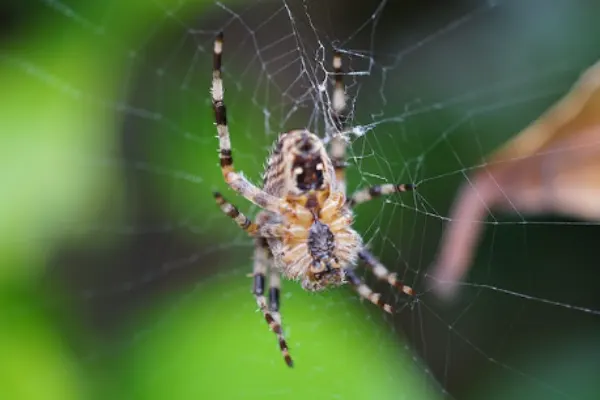
| Scientific name | Araneus nordmanni |
| Size | 13mm |
| Diet | small insects |
| Geographical location | North America, Europe, Russia to Kazakhstan, Korea, Japan and Caucasus |
As the name suggests, Nordmann’s Orbweaver comes under the species of orb weavers of the family Araneidae. Orb means circular/spherical, so their webs are built in a spiral shape. They are found in cold areas, especially in clean and decorated forests.
This particular characteristic makes them a rare species. Its abdomen has a large black area surrounded by patterns of light grey, wellow green or white markings. Its food is mostly flies and other flying insects in the forests. Nordmann’s Orbweaver is not venomous to human beings.
11) Napoleon Spider (White form)
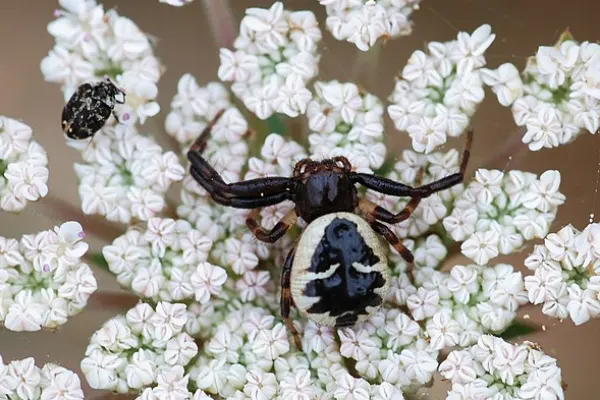
| Scientific name | Synema globosum |
| Size | Female- 9mm, Male- 4mm |
| Diet | small flying insects |
| Geographical location | Most countries of Europe and in the eastern Palearctic regions |
Synema globosum is the binomial name of Napoleon spiders belonging to the family Thomisidae. They are also called crab spiders. It has been given the name Napoleon due to its imprint of Napoleon’s iconic hat silhouette on its abdomen.
This spider’s characteristic feature is that their female species show color variations, unlike males, who only have a black abdomen with two white spots. In females, their abdomen can be red, yellow or white color.
These spiders do not spin webs, instead killing their prey, including invertebrates. Its poison isn’t harmful to human beings.
12) Phidippus Regius
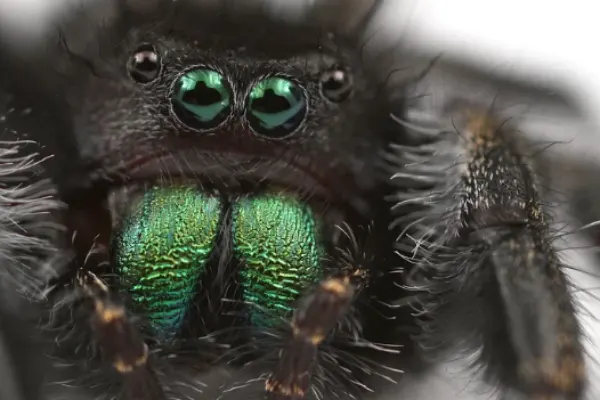
| Scientific name | Phidippus Regius |
| Size | 7mm to 22 mm ,Male- 6 mm to 18 mm |
| Diet | Crickets, flies, roaches, meal worms, wax worms, moths etc |
| Geographical location | US, West Indies and Florida Peninsula |
Also known as ‘regal jumping spiders,‘ Phidippus Regius comes under the broad category of jumping spiders found mostly in eastern North America. Their genders can get easily distinguished due to the color difference.
Males are always black with white spots and stripes, while females may be of the same pattern but show a wide range of colors. They show hesitation in biting; therefore, symptoms are mostly simple swelling and pain.
Regal jumpers are found mostly in open areas and build their silk nests at night on tree barks. Their prey mostly includes living insects, but they can catch 1.5 times bigger living organisms than their own size, making them super special.
13) Shamrock Orbweaver
| Scientific name | Araneus trifolium |
| Size | 4mm to 20 mm |
| Diet | Small flying insects |
| Geographical location | US and Canada |
Shamrock Orbweaver is an Orbweaver species in the Araneidae family. Its abdomen can have diverse colors, mostly seen in beige or brown. It also contains white spots on its abdomen.
Araneus trifolium is seen throughout the United States and Canada. It builds a web to grab its prey like small flying insects. Its venom can be painful but not very dangerous for humans. Shamrock Orbweaver’s legs have black and white stripes. As an orb weaver, its web is also spun circularly.
14) Spiny Orb Weaver Spider
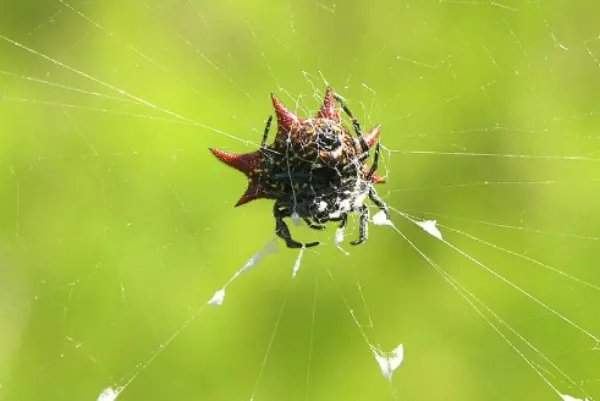
| Scientific name | Gasteracantha cancriformis |
| Size | 30 mm |
| Diet | beetles, moths, mosquitoes and whiteflies |
| Geographical location | Tropical and subtropical areas like from India to Indonesia |
Spiny Orb Weavers/Spiny-backed Orbweavers/ Spiny spiders, scientifically known as Gasteracantha cancriformis, are one of the species of orb weavers. The female gender is widely colored with six significant spines on their abdomen, which appear like a shell. They are called spiny spiders as they have spiny backs.
Females are much broader than males in size that are devoid of spines and vibrant colors. Gasteracantha are widely distributed in tropical and subtropical areas from India to Indonesia. Their bites are generally not hazardous to humans.
And most importantly, orb weavers are the third largest family of spiders in the world. Their food includes small insects that can be entrapped within their web. Hence, it is considered one of the beneficial spiders.
15) Twin flagged jumping Spider
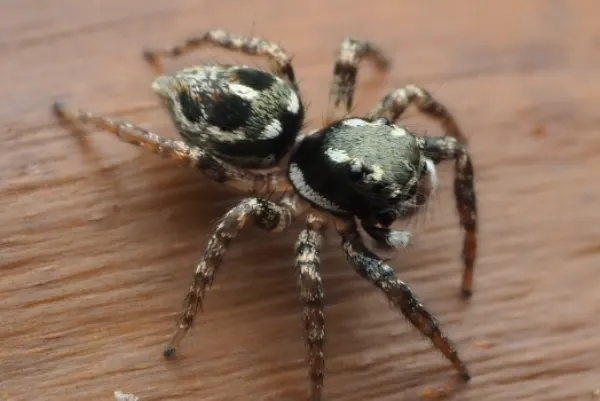
| Scientific name | Anasaitis canosa |
| Size | 5mm to 6mm |
| Diet | a variety of different invertebrates |
| Geographical location | Ranges from Mexico to South Carolina along Gulf of Mexico |
Twin-flagged jumping spider is a tiny jumping spider seen on exterior walls and fences. It is named like this due to the two flag-shaped imprints on the dorsal side of the cephalothorax.
The twin-flagged was previously categorized under the genus Carythalia but later on, mentioned under Anasaitis. These spiders have pavonine scales that are white, black and pink that may appear like flags.
Their most common prey include ants and small insects. They got excellent hunting instincts and methods. Jumping spiders are not much chaotic to human beings as they run away from people. Their bite is not venomous to human beings.
16) White-spotted Swift Spider
| Scientific name | Nyssus albopunctatus |
| Size | 7-9mm |
| Diet | other arthropods |
| Geographical location | Australia and New Zealand |
The White-spotted Swift Spider (Nyssus albopunctatus) is a small, agile arachnid known for its striking appearance.
Found primarily in Australia , it boasts a distinctive white-spotted pattern on its abdomen and legs. This remarkable spider is an adept hunter, using its speed and silk to capture prey with precision.
17) Australian Garden Orb Weavers
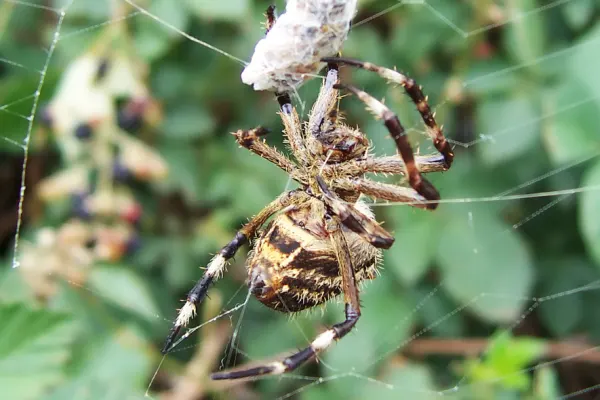
| Scientific name | Eriophora transmarina |
| Size | 2 to 3 centimetres in length for the female and 1.5 to 2 centimetres for the male |
| Diet | Small insects such as flies, moths, beetles, wasps and mosquitoes |
| Geographical location | throughout Australia |
The Australian Garden Orb Weaver (Eriophora transmarina) is a captivating arachnid native to Australia. With its intricate web and vibrant colors, it adds beauty to gardens. Australian Garden Orb Weavers can grow up to 3 cm in length and females are slightly bigger than males.
This spider patiently awaits insects caught in its web, showcasing its impressive hunting skills while contributing to the local ecosystem’s balance.
18) Western Black Widow (Male)
| Scientific name | Latrodectus hesperus |
| Size | 14–16 mm |
| Diet | diplopods, wood lice, chilopods, and other arachnids |
| Geographical location | throughout the western United States |
Now, here in the list of black and white spiders, we have Western Black Widow. These spiders are venomous and potentially harmful to humans. But only the female species are venomous; males are considered to be harmless.
Male Western Black Widows have white and red markings on sides whereas females have only 2 transverse red markings. These spiders are shy and usually attack as a defensive measure.
Other List
-
19) Spined Micrathena
-
20) Nyssus funerea
-
21) Coppered White-cheeked Jumping Spider
-
22) Red-femured Spotted Orbweaver
-
23) False Black Widow
-
24) Bowl and Doily Spider
-
25) Long-Palped Ant-Mimic Sac Spider
-
26) Sylvan Jumping Spider
-
27) Gray wall jumper
-
28) Spotted Ground Spiders
FAQs:
Q1. Are There Any Black Spider With White Stripes?
Ans. Australian Garden Orb Weavers, Shamrock Orbweaver, Nordmann’s Orbweaver, and Stealthy Ground Spider are the names of black spiders with white stripes.
Q2. Are There Any Black Spider With White Spots?
Ans. White-spotted Swift Spider, Peppered Jumping, and Spider Bold Jumper are the black spiders with white spots.
Q3. Names of White Spiders With Black Markings
Ans. White Micrathena, Pantropical Jumper, and Zebra Spider are the names of white spiders with black markings.
Here, we conclude our article on “spiders that are black and white.” We hope you like the list. There are many spiders that can be found in black and white, and most of them are not harmful to us. So, take care, and you can read about a particular spider on various sites.
Also Read:

Meet Monty, the visionary founder of How It See, being an engineering student, he’s fueled by an insatiable curiosity about the world around him. He is captivated by an eclectic correlation between animal groups, science, and nature, and this fascination drives his quest for understanding.
After completing his degree, he’s set on a mission to delve deep into the realm of nature, accumulating knowledge to share with you through his writing. In the meantime, he loves to watch anime and read anime.
